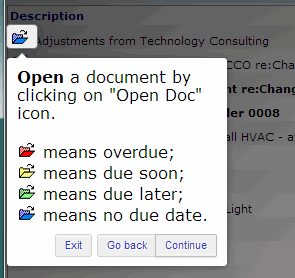From time to time we like to talk about automation in our client webinars because we believe that a system such as the Spitfire Project Management System can make the job of project managers much easier. Why work harder when you can work smarter?
TweetThat Pesky Project Due Date!
 We are all concerned about “THAT DAY” when a project is due…isn’t everyone??
We are all concerned about “THAT DAY” when a project is due…isn’t everyone??
From the start of a new project, that due day looms large. However, there are micro due dates within every project that need to be dealt with on a daily basis in order to meet that “Holy Grail” end date. Project managers who need to stay on top of all these due dates need a project management system that is designed to handle this depth of concept. Being able to see and set multiple levels of due dates specific to each individual project is of paramount importance.
For, of course, each project includes many different documents with their own individual needs; these could include RFIs, RFQs, Pay Requests, Meeting minutes, Compliance requirements, etc… and many more. And there are other levels! Perhaps we have a specific due date for a document that has item-specific due dates. And those items are the responsibilities of specific people who must do their job in order for the next person to do his job, all by specific due dates.
Each missed due date is the potential start of a delay that ends with the project missing it’s major end due date. This is particularly true if a missed due date is not caught and corrected as soon as possible. And a project that does not end in time is usually considered a mismanaged project, often with costly consequences.
That is why the Spitfire Project Management System uses due dates on many different levels. Project Managers indicate the project final due date, and when each document is due, and when individual items on the document are due, and when every person who needs to take action on that document needs to take such action by. Alerts can be set up to notify the project managers when any of the due dates are approaching or have passed.
A proper project management system with complex levels of information and due date tracking will make any project manager’s job that much easier. Perhaps that due date can be met after all!
TweetEnough Features: Is It Easy Too?
As recently as my last blog post, I repeated that we at Spitfire like to talk about the features and functionality of our Spitfire Project Management System. Every once in awhile though, someone says we talk about our features too much! Or at least about too many of the system’s capabilities at one time.
Oh, we get the basic fact that our infrastructure isn’t what sells the system. That’s why we don’t often emphasize the cloud, or single instance storage, or the fact that we have over 700 configurable fields in the web application’s user interface. Even so, for some folks, once you’ve proven a certain level of functionality, they become saturated.
For such folks, it becomes much more about the user experience–and a large part of that is the impressions they get. How easy is this system to use? So just as we pay attention to our users in order to know the features they need most, we also listen and pay very close attention to how people get their job done so that we can make that job easier with each version of our project management system.
User experience is subjective, but some of the things we try to keep tabs on include Continue reading
TweetIncluded Free: Runs in the Cloud
 We saw one of those signs while out shopping this weekend: “We’ll beat the competitor’s price or its FREE!”. So we enjoyed a good chuckle, because who is going to give anything away for free? But they got to use the word “FREE”, and I guess that’s all that matters. Along the same vein, today’s spam included one with the subject “Harness the Speed and Security of the Cloud”. Another chuckle for me…but I don’t think that was the goal of the sender.
We saw one of those signs while out shopping this weekend: “We’ll beat the competitor’s price or its FREE!”. So we enjoyed a good chuckle, because who is going to give anything away for free? But they got to use the word “FREE”, and I guess that’s all that matters. Along the same vein, today’s spam included one with the subject “Harness the Speed and Security of the Cloud”. Another chuckle for me…but I don’t think that was the goal of the sender.
The Wikipedia entry on Cloud Computing admits that the popularity of the term “can be attributed to its use in marketing”. We recognize that emphasizing being a “cloud solution” can be marketing hype and so we don’t talk about “the cloud” as often as we talk about our features.
At Spitfire we are all about the functionality of our Spitfire Project Management System. A very significant portion of that functionality was created as a direct result of listening to our users. We are proud of both that functionality and the technological foundation that has allowed us to build an amazing feature set in our software. So, we talk about our features. A lot.
We don’t want to stop focusing on those features–and we promise we never will–but that same technological foundation that supports all those features was also designed to scale really, really well. Therefore, I’m taking a moment today to emphasize that, yes, of course, the Spitfire Project Management System runs “in the cloud”, and that is equally true whether you think that means Software as a Service (SaaS) or software that scales incredibly well and runs on redundant virtual servers not tied to any local footprint. Continue reading
TweetInfrastructure and Happiness
 Oh boy. I have to admit to being perturbed this morning. See, I’m a bit of road cyclist. I’ve traveled over 600 miles so far this season and there I was this morning on one of my favorite country roads and don’t you know that between last Friday morning and now they have torn up the road to prepare for resurfacing. ARG! And I should have expected it, because a week or two ago they were working on another of my routes. Having grown up in the big city, there is a large part of me that thinks these roads really didn’t need resurfacing for years yet. But, left alone, roads deteriorate. Or in the case of my particular path, increasing population density has made old specifications no longer adequate. No matter the rationale, I’m forced to deal with a ruined ride and disruption for weeks to come. These rides are supposed to reduce stress – but I found myself quite unhappy today.
Oh boy. I have to admit to being perturbed this morning. See, I’m a bit of road cyclist. I’ve traveled over 600 miles so far this season and there I was this morning on one of my favorite country roads and don’t you know that between last Friday morning and now they have torn up the road to prepare for resurfacing. ARG! And I should have expected it, because a week or two ago they were working on another of my routes. Having grown up in the big city, there is a large part of me that thinks these roads really didn’t need resurfacing for years yet. But, left alone, roads deteriorate. Or in the case of my particular path, increasing population density has made old specifications no longer adequate. No matter the rationale, I’m forced to deal with a ruined ride and disruption for weeks to come. These rides are supposed to reduce stress – but I found myself quite unhappy today.

